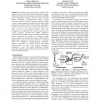Free Online Productivity Tools
i2Speak
i2Symbol
i2OCR
iTex2Img
iWeb2Print
iWeb2Shot
i2Type
iPdf2Split
iPdf2Merge
i2Bopomofo
i2Arabic
i2Style
i2Image
i2PDF
iLatex2Rtf
Sci2ools
MICRO
1999
IEEE
1999
IEEE
Read-After-Read Memory Dependence Prediction
: We identify that typical programs exhibit highly regular read-after-read (RAR) memory dependence streams. We exploit this regularity by introducing read-after-read (RAR) memory dependence prediction. We also present two RAR memory dependence prediction-based memory latency reduction techniques. In the first technique, a load can obtain a value by simply naming a preceding load with which a RAR dependence is predicted. The second technique speculatively converts a series of LOAD1-USE1,...,LOADN-USEN chains into a
| Added | 04 Aug 2010 |
| Updated | 04 Aug 2010 |
| Type | Conference |
| Year | 1999 |
| Where | MICRO |
| Authors | Andreas Moshovos, Gurindar S. Sohi |
Comments (0)

